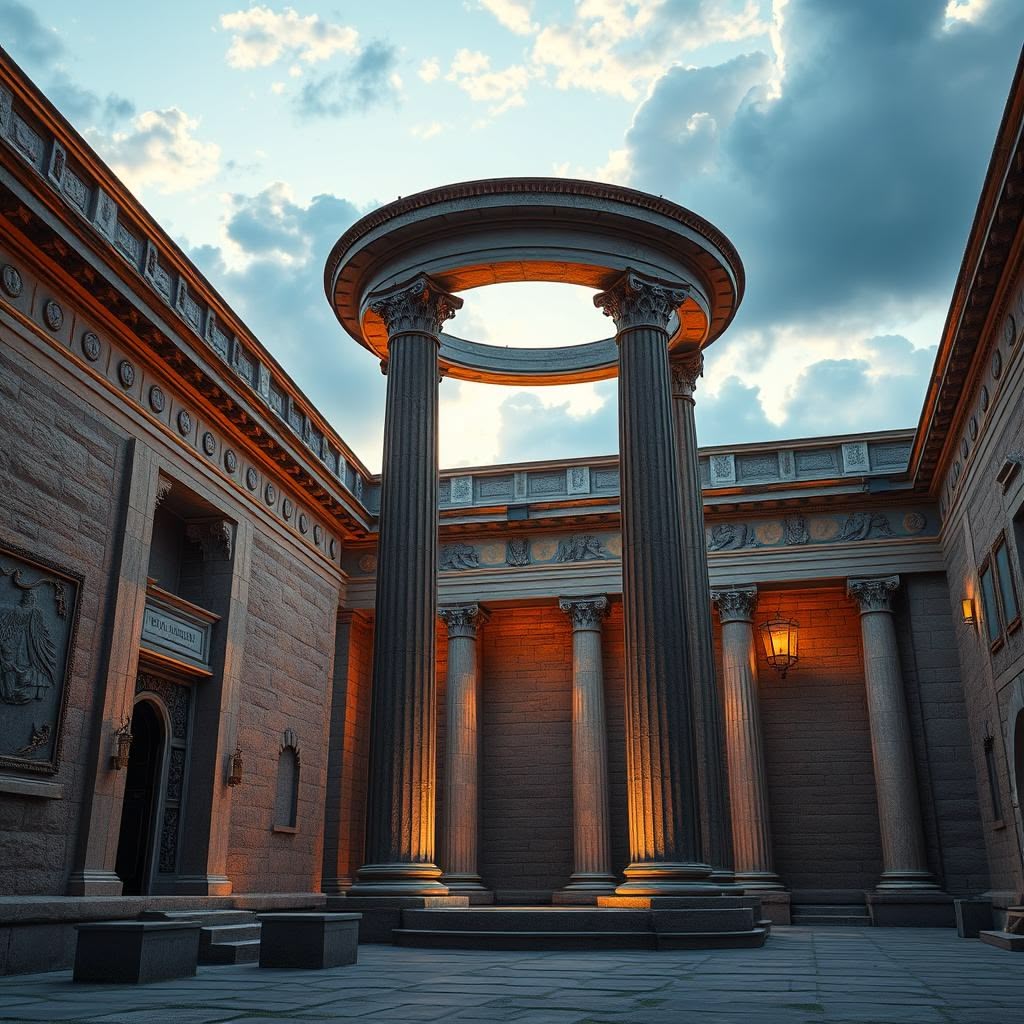Lighting played a crucial role in ancient Roman daily life and architecture, shaping how people lived, worked, and experienced their surroundings. The Romans developed a range of lighting solutions that combined practicality with innovation. Their approach was not limited to artificial illumination but extended to architectural designs that maximized natural light.
Key aspects of Ancient Roman lighting innovations include:
- Mastery of artificial lighting through oil lamps that were widely used for indoor and nighttime activities.
- Innovative use of natural light within buildings, including skylights and strategically placed openings.
- Architectural features designed to optimize daylight penetration, reducing dependence on artificial light sources.
Roman innovations in lighting reflect an advanced understanding of both technology and design. These historical lighting methods set the stage for future developments in how humans illuminate their environments—from the glow of oil lamps to the brilliance brought by skylights.
To gain deeper insights into the daily life in ancient Rome, including the social class divide which influenced aspects such as lighting usage, you can explore this detailed article. Additionally, if you’re interested in experiencing a simulated version of ancient Roman life, JP Farmer’s role-playing journey in Second Life could provide a unique perspective. For further exploration into the remarkable architecture that defined ancient Rome, consider delving into this comprehensive resource on Roman architecture.
Artificial Lighting Innovations: Roman Oil Lamps
Roman oil lamps were the cornerstone of ancient artificial lighting, providing essential illumination for homes, streets, and public spaces after sunset. These lamps were the most common source of artificial light in Roman society, valued for their portability and relatively simple operation.
Materials and Fuels
- Construction materials: Predominantly made from pottery due to its availability and ease of production. Metal versions existed but were less common and often reserved for wealthier households or special uses. Interestingly, some people even attempted to create their own clay oil lamps using DIY methods similar to those employed in ancient Rome, as detailed in this guide.
- Fuels used: Animal fats (such as tallow) and vegetable oils (like olive oil) served as primary fuels. Olive oil was especially prized because it burned cleaner and produced less smoke compared to animal fats.
Design Evolution
Early Roman oil lamps featured basic bowl shapes with a single spout for the wick. Over time, design improvements enhanced efficiency and user convenience:
- Multiple spouts: Some lamps evolved to include two or more spouts, increasing light output without needing additional lamps.
- Reservoir shape: Flattened reservoirs allowed for a more stable flame and longer burn time.
- Wick holders: Innovations in wick placement reduced flickering and minimized smoke production.
- Decorative elements: Designs incorporated motifs from mythology, daily life, or symbols of protection, reflecting social status while serving functional purposes. This is particularly interesting when considering the contrast between the lives of the plebeians, who comprised the majority of the population and relied on these lamps for everyday use, and the patricians, who had access to more luxurious lighting options.
Efficiency Improvements
Roman artisans continually refined lamp shapes to optimize fuel consumption and brightness. The focus on reducing smoke was practical since smoke accumulation inside enclosed spaces could be hazardous. Improved airflow designs around the wick helped maintain a steady flame.
Roman oil lamps exemplify how ancient artificial lighting was not only about illumination but also about combining function with artistry. Their development over centuries shows an ongoing commitment to enhancing everyday life through better lighting technology.

Natural Lighting Techniques in Roman Architecture
The Romans were skilled at using natural daylighting, a concept that can be further explored in this article about letting the sun shine in, in their architectural designs to reduce the need for artificial lighting during the day. Two main features of their natural lighting methods stand out:
The Pantheon Oculus: A Masterpiece of Daylighting
The Pantheon in Rome is a remarkable example of Roman architectural ingenuity with its oculus, a large circular skylight at the top of the dome. This oculus served as the primary source of direct light inside the monument, creating a beautiful interplay of light and shadow that enhanced the interior atmosphere.
Skylights and Open Roof Apertures in Ancient Rome
Ancient Roman skylights were quite different from modern versions, known as “roof lanterns.” These open roof openings allowed natural light and fresh air to enter indoor spaces without the use of glass coverings. The absence of glass not only facilitated ventilation but also maintained a connection to the outdoors, blurring the boundaries between inside and outside spaces.
By carefully incorporating skylights and open roof openings into their architectural designs, which are part of a broader glossary of architecture, the Romans achieved a harmonious balance between natural light and structural functionality. This architectural skill is just one example of the incredible Roman engineering feats that have had a lasting impact on future generations, serving as a foundation for modern infrastructure systems.
These architectural advancements were part of a larger picture of the spectacle of ancient Rome, which included gladiatorial games, chariot races, and theatrical performances that captivated society. These events not only provided entertainment but also had significant effects on social relationships and political authority.
In addition to entertainment, the Romans also made substantial contributions to legal systems with The Twelve Tables, which marked a significant milestone in the development of Roman law. Created between 451-450 BCE, these laws were the first attempt to codify the complex legal practices of ancient Rome.
Furthermore, the legacy of ancient Rome continues to shape Western civilization today. From its beginnings as a small city-state to its transformation into a vast empire, Rome’s influence is both profound and enduring. The impact of Roman culture, governance, and innovations can be seen in various aspects of modern society.
Finally, it’s important to recognize that agriculture played a crucial role in driving Roman economic growth. This sector extended beyond mere food production; it was integral to social development as well.
Windows and Strategic Openings for Daylight Penetration in Roman Buildings
The design of Roman windows played a crucial role in maximizing daylight, complementing other lighting innovations like oil lamps and skylights. Romans understood that the placement and size of windows directly affected how sunlight penetrated interior spaces. Their buildings often featured carefully positioned openings that captured natural light while considering the sun’s path throughout the day.
Key aspects of Roman window design included:
- Orientation: Windows were typically placed on south-facing walls to maximize exposure to sunlight during winter months when warmth and light were most needed.
- Size and Shape: Window openings varied from small slit-like apertures to larger rectangular or arched forms. Larger windows were common in public buildings such as basilicas, allowing ample illumination of vast interiors.
- Integration with Architecture: Windows were not isolated features but integrated into the overall building layout. For example, atria often had openings above to allow light into central courtyards, which then reflected light into surrounding rooms.
- Use of Grilles and Screens: To control airflow and provide security without blocking daylight, Romans sometimes installed metal grilles or wooden screens over window openings.
This strategic approach to window placement optimized daylight penetration, reducing dependence on artificial lighting during daytime hours. It also enhanced ventilation and contributed to comfort inside Roman buildings.
Roman lighting innovations from oil lamps to skylights found a natural partner in these well-planned architectural openings, demonstrating a comprehensive vision for illuminated living spaces. The influence of such architectural advancements can be seen in various aspects of Roman society, including their military strategies as exemplified by figures like Scipio Africanus, whose victories helped establish Rome’s dominance, and the Roman Army, a symbol of military power that played a crucial role in the growth and upkeep of the empire.
These architectural strategies also facilitated the expansion and maintenance of the empire through Roman roads, which served as vital arteries for trade and military movement. Such advancements underscore the comprehensive vision behind Roman architecture, extending beyond mere aesthetics to include functionality that supported their vast empire.
Legacy of Roman Lighting Innovations on Later Developments
The ancient Roman lighting innovations significantly influenced the historical lighting evolution throughout history. The foundational principles established by the Romans in both artificial and natural lighting techniques served as a cornerstone for future developments.
Influence on Illumination Methods
Roman oil lamp designs and architectural features like skylights paved the way for advancements in illumination methods. The strategic use of natural light in Roman buildings inspired later architects to prioritize daylighting in their designs. This approach aligns with the Stoic philosophy that emphasized living in harmony with nature, which shaped Roman thought and subsequently influenced various aspects of life including architecture.
Enduring Influence on Modern Lighting Systems
The legacy of Roman lighting innovations can be seen in modern lighting systems that aim for energy efficiency and sustainability. These advancements are a testament to the enduring influence of ancient Rome, reflecting not just in our lighting technology but also in our overall approach towards resource utilization, echoing the comprehensive system that intertwined their religious practices with every aspect of their lives as explored in Ancient Roman religion, and how this interconnection influenced politics, culture, and social structures.
Conclusion
The historical significance of Ancient Roman Lighting Innovations: From Oil Lamps to Skylights reveals that the Romans were pioneers in both artificial and natural lighting techniques. This is just one aspect of the larger rise and fall of the Roman Empire, a civilization that has had a lasting impact on politics, culture, and society.
The legacy of Roman lighting innovations continues to shape modern ideas of illumination, demonstrating the enduring influence of their advancements in architectural design and everyday life. This influence goes beyond lighting, as seen in areas such as law, where Roman Law serves as the foundation of modern legal systems.
By skillfully combining artificial light sources like oil lamps with architectural wonders such as skylights, the Romans established a standard for improving both indoor and outdoor lighting solutions. Their pioneering spirit and creativity are not only evident in their lighting innovations but also in their legal contributions, exemplified by the Corpus Juris Civilis, a significant achievement that adapted ancient Roman legal principles to contemporary needs.
The summary of Roman lighting innovations highlights their pioneering spirit and creativity, emphasizing how these ancient methods have influenced our current practices of illuminating spaces. Furthermore, the rich tapestry of art and culture in ancient Rome provides insight into their artistic expressions which were heavily influenced by earlier traditions. Additionally, the influence of Roman mythology on modern culture reflects how deeply ingrained these ancient stories are in our societal norms and political aspirations.

